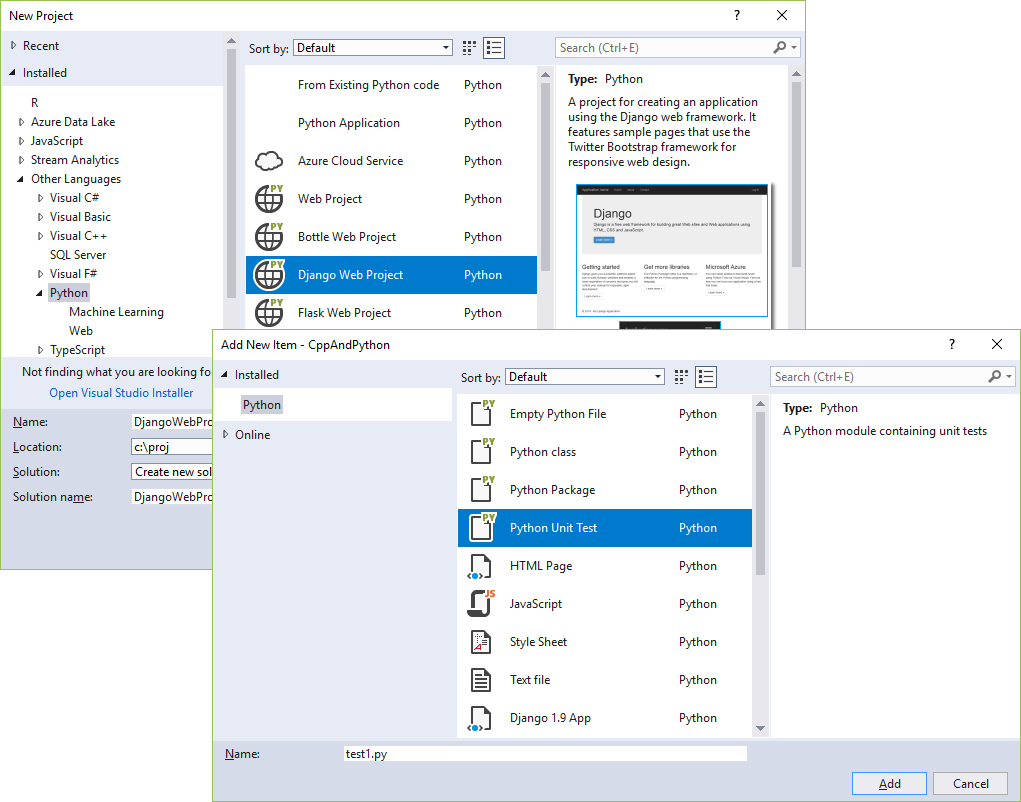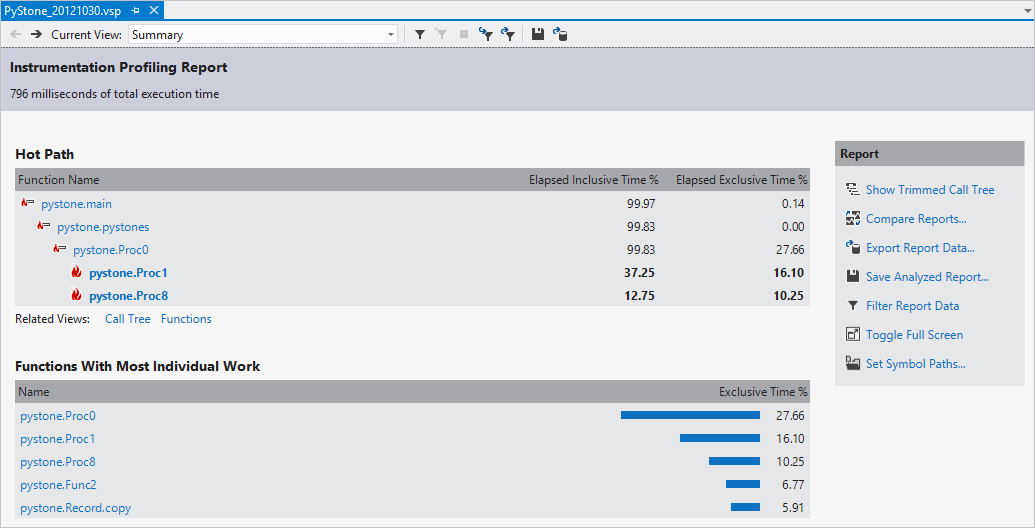Work with Python in Visual Studio on Windows
Applies to: ![]() Visual Studio
Visual Studio ![]() Visual Studio for Mac
Visual Studio for Mac
Note
This article applies to Visual Studio 2017. If you're looking for the latest Visual Studio documentation, see Visual Studio documentation. We recommend upgrading to the latest version of Visual Studio. Download it here
Python is a popular programming language that is reliable, flexible, easy to learn, free to use on all operating systems, and supported by both a strong developer community and many free libraries. Python supports all manners of development, including web applications, web services, desktop apps, scripting, and scientific computing. Scientists, casual developers, professional developers, and many universities alike use Python for programming. You can learn more about the language on python.org and Python for Beginners.
Visual Studio is a powerful Python IDE on Windows. Visual Studio provides open-source support for the Python language through the Python Development and Data Science workloads (Visual Studio 2017 and later) and the free Python Tools for Visual Studio extension (Visual Studio 2015 and earlier).
Visual Studio doesn't support Python on Mac now. But it's available on Mac and Linux through Visual Studio Code. (see questions and answers).
To get started:
- Follow the installation instructions to set up the Python workload.
- Familiarize yourself with the Python capabilities of Visual Studio through the sections in this article.
- Go through one or more of the Quickstarts to create a project. If you're unsure, start with Create a web app with Flask.
Note
Visual Studio supports Python version 2.7, as well as version 3.5 through 3.7. While it is possible to use Visual Studio to edit code written in other versions of Python, those versions aren't officially supported and features such as IntelliSense and debugging might not work. Python version 3.8 support is still under development, specific details about support can be seen in this tracking issue on GitHub.
- Follow the Work with Python in Visual Studio tutorial for a full end-to-end experience.
Support for multiple interpreters
Visual Studio's Python Environments window (shown below in a wide, expanded view) gives you a single place to manage all of your global Python environments, conda environments, and virtual environments. Visual Studio automatically detects installations of Python in standard locations, and allows you to configure custom installations. With each environment, you can easily manage packages, open an interactive window for that environment, and access environment folders.
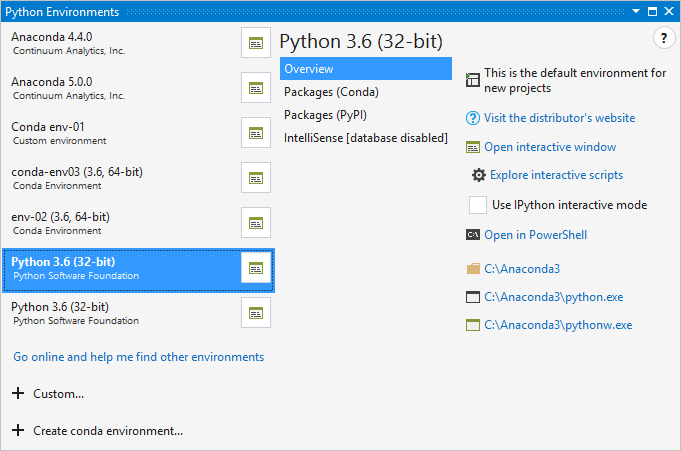
Use the Open interactive window command to run Python interactively within the context of Visual Studio. Use the Open in PowerShell command to open a separate command window in the folder of the selected environment. From that command window you can run any python script.
For more information:
Rich editing, IntelliSense, and code comprehension
Visual Studio provides a first-class Python editor, including syntax coloring, autocomplete across all your code and libraries, code formatting, signature help, refactoring, linting, and type hints. Visual Studio also provides unique features like class view, Go to Definition, Find All References, and code snippets. Direct integration with the Interactive window helps you quickly develop Python code that's already saved in a file.

For more information:
- Docs: Edit Python code
- Docs: Format code
- Docs: Refactor code
- Docs: Use a linter
- General Visual Studio feature docs: Features of the code editor
Interactive window
For every Python environment known to Visual Studio, you can easily open the same interactive (REPL) environment for a Python interpreter directly within Visual Studio, rather than using a separate command prompt. You can easily switch between environments as well. (To open a separate command prompt, select your desired environment in the Python Environments window, then select the Open in PowerShell command as explained earlier under Support for multiple interpreters.)
Visual Studio also provides tight integration between the Python code editor and the Interactive window. The Ctrl+Enter keyboard shortcut conveniently sends the current line of code (or code block) in the editor to the Interactive window, then moves to the next line (or block). Ctrl+Enter lets you easily step through code without having to run the debugger. You can also send selected code to the Interactive window with the same keystroke, and easily paste code from the Interactive window into the editor. Together, these capabilities allow you to work out details for a segment of code in the Interactive window and easily save the results in a file in the editor.
Visual Studio also supports IPython/Jupyter in the REPL, including inline plots, .NET, and Windows Presentation Foundation (WPF).
For more information:
Project system, and project and item templates
Visual Studio helps you manage the complexity of a project as it grows over time. A Visual Studio project is much more than a folder structure: it includes an understanding of how different files are used and how they relate to each other. Visual Studio helps you distinguish app code, test code, web pages, JavaScript, build scripts, and so on, which then enable file-appropriate features. A Visual Studio solution, moreover, helps you manage multiple related projects, such as a Python project and a C++ extension project.
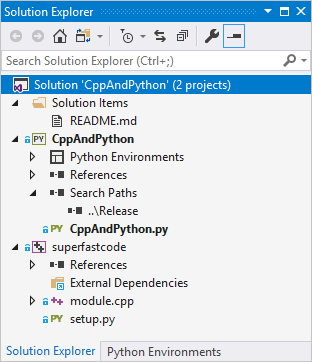
Project and item templates automate the process of setting up different types of projects and files, saving you valuable time and relieving you from managing intricate and error-prone details. Visual Studio provides templates for web, Azure, data science, console, and other types of projects, along with templates for files like Python classes, unit tests, Azure web configuration, HTML, and even Django apps.
For more information:
- Docs: Manage Python projects
- Docs: Item templates reference
- Docs: Python project templates
- Docs: Work with C++ and Python
- General Visual Studio feature docs: Project and item templates
- General Visual Studio feature docs: Solutions and projects in Visual Studio
Full-featured debugging
One of Visual Studio's strengths is its powerful debugger. For Python in particular, Visual Studio includes Python/C++ mixed-mode debugging, remote debugging on Linux, debugging within the Interactive window, and debugging Python unit tests.
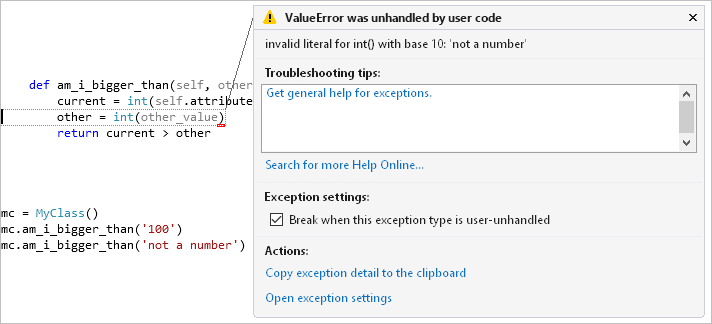
For more information:
- Docs: Debug Python
- Docs: Python/C++ mixed-mode debugging
- Docs: Remote debugging on Linux
- General Visual Studio feature docs: Feature tour of the Visual Studio Debugger
Profiling tools with comprehensive reporting
Profiling explores how time is being spent within your application. Visual Studio supports profiling with CPython-based interpreters and includes the ability to compare performance between different profiling runs.
For more information:
- Docs: Python profiling tools
- General Visual Studio feature docs: Profiling Feature Tour. (Not all Visual Studio profiling features are available for Python).
Unit testing tools
Discover, run, and manage tests in Visual Studio Test Explorer, and easily debug unit tests.
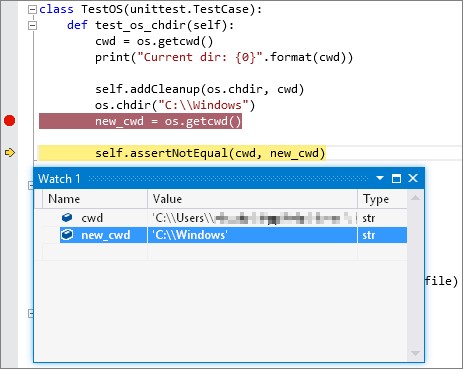
For more information:
- Docs: Unit testing tools for Python
- General Visual Studio feature docs: Unit test your code.
Azure SDK for Python
The Azure libraries for Python simplify consuming Azure services from Windows, macOS X, and Linux apps. You can use them to create and manage Azure resources, and to connect to Azure services.
For more information, see Azure SDK for Python and Azure libraries for Python .
Questions and answers
Q. Is Python support available with Visual Studio for Mac?
A. Not at this time, but you can up vote the request on Developer Community. The Visual Studio for Mac documentation identifies the current types of development that it does support. In the meantime, Visual Studio Code on Windows, Mac, and Linux works well with Python through available extensions.
Q. What can I use to build UI with Python?
A. The main offering in this area is the Qt Project, with bindings for Python known as PySide (the official binding) (also see PySide downloads) and PyQt. Python support in Visual Studio doesn't include any specific tools for UI development.
Q. Can a Python project produce a stand-alone executable?
A. Python is generally an interpreted language, with which code is run on demand in a suitable Python-capable environment such as Visual Studio and web servers. Visual Studio itself doesn't now provide the means to create a stand-alone executable, which essentially means a program with an embedded Python interpreter. However, the Python community supplied different means to create executables as described on StackOverflow. CPython also supports being embedded within a native application, as described on the blog post, Using CPython's embeddable zip file.
Feature support
Python features can be installed in the following editions of Visual Studio as described in the installation guide:
- Visual Studio 2022 (all editions)
- Visual Studio 2019 (all editions)
- Visual Studio 2017 (all editions)
- Visual Studio 2015 (all editions)
- Visual Studio 2013 Community Edition
- Visual Studio 2013 Express for Web, Update 2 or higher
- Visual Studio 2013 Express for Desktop, Update 2 or higher
- Visual Studio 2013 (Pro edition or higher)
- Visual Studio 2012 (Pro edition or higher)
- Visual Studio 2010 SP1 (Pro edition or higher; .NET 4.5 required)
Visual Studio 2015 and earlier are available at visualstudio.microsoft.com/vs/older-downloads/.
Important
Features are fully supported and maintained for only the latest version of Visual Studio. Features are available in older versions but aren't actively maintained.
| Python support | 2017+ | 2015 | 2013 Comm | 2013 Desktop | 2013 Web | 2013 Pro+ | 2012 Pro+ | 2010 SP1 Pro+ |
|---|---|---|---|---|---|---|---|---|
| Manage multiple interpreters | ✔ | ✔ | ✔ | ✔ | ✔ | ✔ | ✔ | ✔ |
| Autodetect popular interpreters | ✔ | ✔ | ✔ | ✔ | ✔ | ✔ | ✔ | ✔ |
| Add custom interpreters | ✔ | ✔ | ✔ | ✔ | ✔ | ✔ | ✔ | ✔ |
| Virtual Environments | ✔ | ✔ | ✔ | ✔ | ✔ | ✔ | ✔ | ✔ |
| Pip/Easy Install | ✔ | ✔ | ✔ | ✔ | ✔ | ✔ | ✔ | ✔ |
| Project system | 2017+ | 2015 | 2013 Comm | 2013 Desktop | 2013 Web | 2013 Pro+ | 2012 Pro+ | 2010 SP1 Pro+ |
|---|---|---|---|---|---|---|---|---|
| New project from existing code | ✔ | ✔ | ✔ | ✔ | ✔ | ✔ | ✔ | ✔ |
| Show all files | ✔ | ✔ | ✔ | ✔ | ✔ | ✔ | ✔ | ✔ |
| Source control | ✔ | ✔ | ✔ | ✔ | ✔ | ✔ | ✔ | ✔ |
| Git integration | ✔ | ✔ | ✔ | ✔ | ✔ | ✔ | ✔1 | ✗ |
| Editing | 2017+ | 2015 | 2013 Comm | 2013 Desktop | 2013 Web | 2013 Pro+ | 2012 Pro+ | 2010 SP1 Pro+ |
|---|---|---|---|---|---|---|---|---|
| Syntax highlighting | ✔ | ✔ | ✔ | ✔ | ✔ | ✔ | ✔ | ✔ |
| Autocomplete | ✔ | ✔ | ✔ | ✔ | ✔ | ✔ | ✔ | ✔ |
| Signature help | ✔ | ✔ | ✔ | ✔ | ✔ | ✔ | ✔ | ✔ |
| Quick info | ✔ | ✔ | ✔ | ✔ | ✔ | ✔ | ✔ | ✔ |
| Object browser/class view | ✔ | ✔ | ✔ | ✔ | ✔ | ✔ | ✔ | ✔ |
| Navigation bar | ✔ | ✔ | ✔ | ✔ | ✔ | ✔ | ✔ | ✔ |
| Go to Definition | ✔ | ✔ | ✔ | ✔ | ✔ | ✔ | ✔ | ✔ |
| Navigate to | ✔ | ✔ | ✔ | ✔ | ✔ | ✔ | ✔ | ✔ |
| Find All References | ✔ | ✔ | ✔ | ✔ | ✔ | ✔ | ✔ | ✔ |
| Auto indentation | ✔e | ✔ | ✔ | ✔ | ✔ | ✔ | ✔ | ✔ |
| Code formatting | ✔ | ✔ | ✔ | ✔ | ✔ | ✔ | ✔ | ✔ |
| Refactor - rename | ✔ | ✔ | ✔ | ✔ | ✔ | ✔ | ✔ | ✔ |
| Refactor - extract method | ✔ | ✔ | ✔ | ✔ | ✔ | ✔ | ✔ | ✔ |
| Refactor - add/remove import | ✔ | ✔ | ✔ | ✔ | ✔ | ✔ | ✔ | ✔ |
| PyLint | ✔ | ✔ | ✔ | ✔ | ✔ | ✔ | ✔ | ✔ |
| Interactive window | 2017+ | 2015 | 2013 Comm | 2013 Desktop | 2013 Web | 2013 Pro+ | 2012 Pro+ | 2010 SP1 Pro+ |
|---|---|---|---|---|---|---|---|---|
| Interactive window | ✔ | ✔ | ✔ | ✔ | ✔ | ✔ | ✔ | ✔ |
| IPython with inline graphs | ✔ | ✔ | ✔ | ✔ | ✔ | ✔ | ✔ | ✔ |
| Desktop | 2017+ | 2015 | 2013 Comm | 2013 Desktop | 2013 Web | 2013 Pro+ | 2012 Pro+ | 2010 SP1 Pro+ |
|---|---|---|---|---|---|---|---|---|
| Console/Windows application | ✔ | ✔ | ✔ | ✔ | ✔ | ✔ | ✔ | ✔ |
| IronPython WPF (with XAML designer) | ✔ | ✔ | ✔ | ✔ | ✔ | ✔ | ✔ | ✔ |
| IronPython Windows Forms | ✔ | ✔ | ✔ | ✔ | ✔ | ✔ | ✔ | ✔ |
| Web | 2017+ | 2015 | 2013 Comm | 2013 Desktop | 2013 Web | 2013 Pro+ | 2012 Pro+ | 2010 SP1 Pro+ |
|---|---|---|---|---|---|---|---|---|
| Django web project | ✔ | ✔ | ✔ | ✗ | ✔ | ✔ | ✔ | ✔ |
| Bottle web project | ✔ | ✔ | ✔ | ✗ | ✔ | ✔ | ✔ | ✔ |
| Flask web project | ✔ | ✔ | ✔ | ✗ | ✔ | ✔ | ✔ | ✔ |
| Generic web project | ✔ | ✔ | ✔ | ✗ | ✔ | ✔ | ✔ | ✔ |
| Azure | 2017+ | 2015 | 2013 Comm | 2013 Desktop | 2013 Web | 2013 Pro+ | 2012 Pro+ | 2010 SP1 Pro+ |
|---|---|---|---|---|---|---|---|---|
| Deploy to web site | ✔ | ✔ | ✔ | ✗ | ✔ | ✔ | ✔ | ✔2 |
| Deploy to web role | ✔ | ✔ | ✔ | ✗ | ✔4 | ✔4 | ✔3 | ✗ |
| Deploy to worker role | ? | ? | ? | ✗ | ✔4 | ✔4 | ✔3 | ✗ |
| Run in Azure emulator | ? | ? | ? | ✗ | ✔4 | ✔4 | ✔3 | ✗ |
| Remote debugging | ✔ | ✔ | ✔ | ✗ | ✔6 | ✔8 | ✔8 | ✗ |
| Attach Server Explorer | ✔ | ✔ | ✔ | ✗ | ✔7 | ✔7 | ✗ | ✗ |
| Django templates | 2017+ | 2015 | 2013 Comm | 2013 Desktop | 2013 Web | 2013 Pro+ | 2012 Pro+ | 2010 SP1 Pro+ |
|---|---|---|---|---|---|---|---|---|
| Debugging | ✔ | ✔ | ✔ | ✗ | ✔ | ✔ | ✔ | ✔ |
| Autocomplete | ✔ | ✔ | ✔ | ✗ | ✔5 | ✔5 | ✔ | ✔ |
| Autocomplete for CSS and JavaScript | ✔ | ✔ | ✔ | ✗ | ✔5 | ✔5 | ✗ | ✗ |
| Debugging | 2017+ | 2015 | 2013 Comm | 2013 Desktop | 2013 Web | 2013 Pro+ | 2012 Pro+ | 2010 SP1 Pro+ |
|---|---|---|---|---|---|---|---|---|
| Debugging | ✔ | ✔ | ✔ | ✔ | ✔ | ✔ | ✔ | ✔ |
| Debugging without a project | ✔ | ✔ | ✔ | ✔ | ✔ | ✔ | ✔ | ✔ |
| Debugging - attach to editing | ✔ | ✔ | ✔ | ✔ | ✗ | ✔ | ✔ | ✔ |
| Mixed-mode debugging | ✔ | ✔ | ✔ | ✔ | ✔ | ✔ | ✔ | ✗ |
| Remote debugging (Windows, macOS X, Linux) | ✔ | ✔ | ✔ | ✔ | ✗ | ✔ | ✔ | ✔ |
| Debug Interactive window | ✔ | ✔ | ✔ | ✔ | ✔ | ✔ | ✔ | ✔ |
| Profiling | 2017+ | 2015 | 2013 Comm | 2013 Desktop | 2013 Web | 2013 Pro+ | 2012 Pro+ | 2010 SP1 Pro+ |
|---|---|---|---|---|---|---|---|---|
| Profiling | ✔ | ✔ | ✔ | ✗ | ✗ | ✔ | ✔ | ✔ |
| Test | 2017+ | 2015 | 2013 Comm | 2013 Desktop | 2013 Web | 2013 Pro+ | 2012 Pro+ | 2010 SP1 Pro+ |
|---|---|---|---|---|---|---|---|---|
| Test explorer | ✔ | ✔ | ✔ | ✔ | ✔ | ✔ | ✔ | ✗ |
| Run test | ✔ | ✔ | ✔ | ✔ | ✔ | ✔ | ✔ | ✗ |
| Debug test | ✔ | ✔ | ✔ | ✔ | ✔ | ✔ | ✔ | ✗ |
Git support for Visual Studio 2012 is available in the Visual Studio Tools for Git extension, available on the Visual Studio Marketplace.
Deployment to Azure Web Site requires Azure SDK for .NET 2.1 - Visual Studio 2010 SP1. Later versions don't support Visual Studio 2010.
Support for Azure Web Role and Worker Role requires Azure SDK for .NET 2.3 - VS 2012 or later.
Support for Azure Web Role and Worker Role requires Azure SDK for .NET 2.3 - VS 2013 or later.
Django template editor in Visual Studio 2013 has some known issues that are resolved by installing Update 2.
Requires Windows 8 or later. Visual Studio 2013 Express for Web doesn't have the Attach to Process dialog, but Azure Web Site remote debugging is still possible using the Attach Debugger (Python) command in Server Explorer. Remote debugging requires Azure SDK for .NET 2.3 - Visual Studio 2013 or later.
Requires Windows 8 or later. Attach Debugger (Python) command in Server Explorer requires Azure SDK for .NET 2.3 - Visual Studio 2013 or later.
Requires Windows 8 or later.
